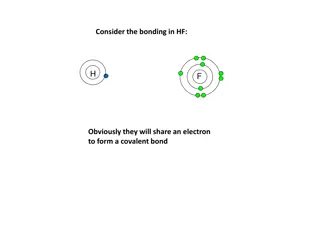Understanding Metallic Bonding and Giant Metallic Lattices
Metallic bonding involves the attraction of positive metal ions to delocalized electrons, forming giant metallic lattices. In this structure, positive metal ions occupy fixed positions while electrons move freely throughout. This bonding is different from covalent bonding as it is delocalized, leading to unique properties in metals like high melting and boiling points. Magnesium, for example, demonstrates strong bonding due to 2 delocalized electrons shared by each atom in its lattice.
Download Presentation

Please find below an Image/Link to download the presentation.
The content on the website is provided AS IS for your information and personal use only. It may not be sold, licensed, or shared on other websites without obtaining consent from the author. Download presentation by click this link. If you encounter any issues during the download, it is possible that the publisher has removed the file from their server.
E N D
Presentation Transcript
Metallic Bonding and Structure Describe metallic bonding as the attraction of positive ions to delocalised electrons. Describe giant metallic lattices. Key words: Metallic bonding, delocalised electrons, giant metallic lattice.
Metallic Bonding and Structure Metallic Bonding: is the electrostatic interaction between positive metal ions and delocalised electrons. Atoms in a solid metal are held together by metallic bonding In metallic bonding the atoms are ionised. Positive ions occupy fixed positions in the lattice The outer shell electrons are delocalised. They are shared between all the atoms in the metallic structure. The metal is held together by the attraction between the positive ions and the negative electrons
Metallic Bonding and Structure Delocalised electrons: are shared between two or more atoms Giant Metallic Lattice: is a 3-D structure of positive ions and delocalised electrons, bonded through strong metallic bonds. In a giant metallic lattice: Delocalised electrons are spread throughout the structure. These are able to move within the structure It is impossible to tell which electron originated from which particular ion. Over the whole structure, the charges must balance.
Example Sodium has the electronic structure 1s22s22p63s1. When sodium atoms come together, the electron in the 3s atomic orbital of one sodium atom shares space with the corresponding electron on a neighbouring atom to form a molecular orbital. This is similar to the way that a covalent bond is formed.
How is metallic bonding different from covalent bonding? Covalent bonds are localised Metallic bonds are delocalised.
Describe the bonding in magnesium.
Magnesium has 2 electrons in outer shell. 2 delocalised electrons shared by each atom in the lattice The positive ions are attracted to the delocalised electrons. Magnesium atom smaller so electrons closer to nucleus This gives stronger bonding leading to higher melting and boiling points.
Properties of Giant Metallic Lattices High melting and boiling points Good electrical conductors Malleable and Ductile
High melting and boiling points Most metals have high melting and boiling points. The electrons are free to move throughout the structure, but the positive ions are fixed in the lattice. The metallic bonds between the positive metal ions and the delocalised electrons are strong. High temperatures are needed to break the metallic bonds and move the ions from the fixed points within the lattice.
Na+ Mg2+ Al3+ Increasing electron cloud density as more electrons are donated per atom. This means the ions are held more strongly
Why do metals conduct electricity so well? The delocalised electrons can move freely anywhere within the metal lattice allowing them to conduct electricity.
Why are metals malleable? Malleable means that the metal can be hammered and pressed into shape. The atoms are able to roll over each other into new positions without breaking the metallic bonds.
Why are metals ductile? Ductile means that they can be drawn out into a wire. This is also due to the ability of the atoms to roll over each other.
Malleability and Ductility The atoms are able to roll past each other into new positions without breaking the metallic bonds.
Alloys What is an alloy? A mixture of metals Metal Alloy They are not a compound as there can be different proportions/ratios of metals Alloys modify a metal s properties The ions may be different sizes, stopping the layers moving past each other, making the metal harder as a result.
Questions 1)What is meant by metallic bonding? 2)How does a metal conduct electricity? 3)Explain how metallic bonding is different from covalent bonding.
Questions 1)What is meant by metallic bonding? 2)How does a metal conduct electricity? 3)Explain how metallic bonding is different from covalent bonding.
Questions Someone looking at a model showing the arrangement of atoms in a copper crystal might think that the following statements are true. Which of these ideas are correct? Which ideas are false? And why. Copper crystals are shaped like cubes because the atoms are packed in a cubic pattern. There is air between the atoms in a crystal of copper. Copper is dense because the atoms are closely packed. The atoms in a copper crystal are not moving at room temperature. Copper has a high melting point because the atoms are strongly bonded in a giant structure. Copper melts when strongly heated because the atoms melt. There are positive metal ions in a metal crystal, but a metal is not an ionic compound. Explain.























